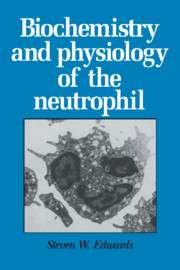Book contents
- Frontmatter
- Contents
- Abbreviations
- Preface
- 1 Neutrophils and host defence: The fight against infection
- 2 The development and structure of mature neutrophils
- 3 The generation and recognition of neutrophil-activating factors: Structure and function of neutrophil receptors
- 4 The cytoskeleton: The molecular framework regulating cell shape and the traffic of intracellular components
- 5 The respiratory burst: The generation of reactive oxygen metabolites and their role in microbial killing
- 6 Neutrophil activation: The production of intracellular signalling molecules
- 7 Neutrophil priming: Regulation of neutrophil function during inflammatory activation
- 8 Disorders of neutrophil function
- Index
6 - Neutrophil activation: The production of intracellular signalling molecules
Published online by Cambridge University Press: 26 February 2010
- Frontmatter
- Contents
- Abbreviations
- Preface
- 1 Neutrophils and host defence: The fight against infection
- 2 The development and structure of mature neutrophils
- 3 The generation and recognition of neutrophil-activating factors: Structure and function of neutrophil receptors
- 4 The cytoskeleton: The molecular framework regulating cell shape and the traffic of intracellular components
- 5 The respiratory burst: The generation of reactive oxygen metabolites and their role in microbial killing
- 6 Neutrophil activation: The production of intracellular signalling molecules
- 7 Neutrophil priming: Regulation of neutrophil function during inflammatory activation
- 8 Disorders of neutrophil function
- Index
Summary
Introduction
Whilst the neutrophil has one primary function – namley, to recognise and destroy microbial pathogens – many separate but interrelated processes are required to control this function. For example, the neutrophil must be able to detect a variety of pro- and anti-inflammatory signals in its microenvironment and then respond accordingly. The responses to these signals include up-regulation of receptor number and function, adherence, diapedesis, chemotaxis, particle binding, phagocytosis, degranulation and activation of the NADPH oxidase. There may also be, where appropriate, the generation of further pro-inflammatory mediators, such as eicosanoids and secondary cytokines. Furthermore, these responses must be terminated when the noxious agent or pathogen has been eliminated. Such deactivation mechanisms of neutrophil function are almost as important as the activation mechanisms, because prolonged or inappropriate neutrophil activity can lead to inflammatory damage via the secretion or overproduction of cytotoxic products.
All known physiological and pathological agents activate neutrophils by first binding to plasma membrane receptors, details of which are given in Chapter 3. The cells must respond either to soluble agonists, which generally signal events such as changes in receptor expression, adherence, aggregation and chemotaxis, or else to particulate stimuli (e.g. opsonised bacteria and immune complexes), which generally stimulate phagocytosis. However, some soluble agonists (e.g. fMet-Leu-Phe, C5a and LTB4) stimulate adherence and chemotaxis (which are early events in the inflammatory response of neutrophils) at low concentrations, but at higher concentrations can activate degranulation and reactive oxidant production (which are later functional responses).
- Type
- Chapter
- Information
- Biochemistry and Physiology of the Neutrophil , pp. 188 - 234Publisher: Cambridge University PressPrint publication year: 1994



